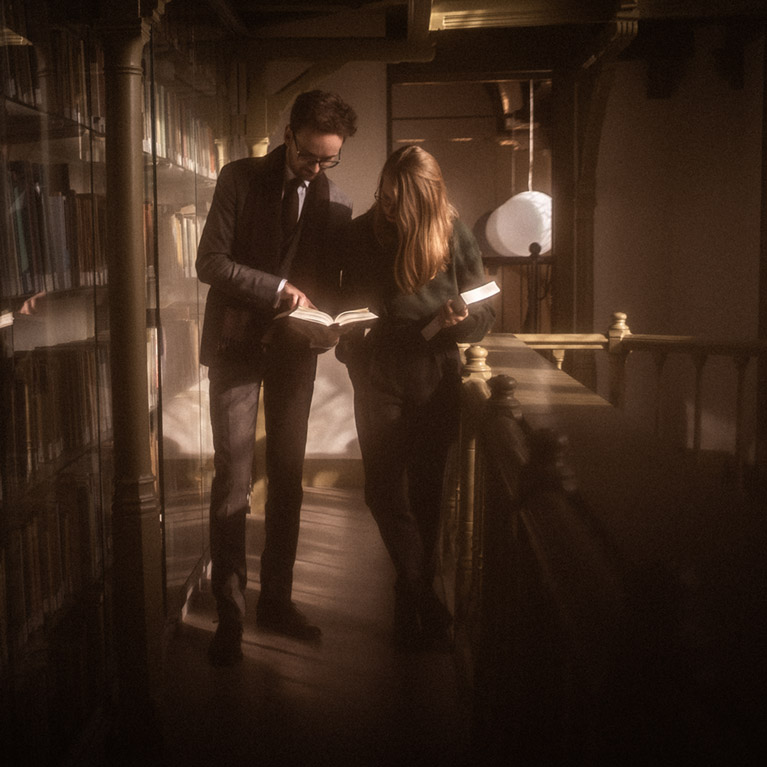
Old books, dark wood, stained glass
The UG’s all about dark academia
Autumn has arrived in Groningen, announcing itself with fallen leaves, murky puddles and dusky afternoons. Couple that with the UG’s neo-Gothic buildings and you end up with a specific aesthetic: dark academia.
Never heard of it? Think of going to class with your books in a leather satchel, wearing a turtleneck and a long tweed coat to protect you against the crisp November air. Think of Friday nights spent reading Lord Byron in front of a fireplace instead of drinking cocktails at Sunny Beach nightclub. In short: imagine university life with a dash of nostalgia.
Dark academia romanticises knowledge production as an artisanal trait
‘What we see in dark academia is an appreciation of a university’s past, in contrast with the everyday reality of higher education’, explains media studies researcher Lars de Wildt. ‘It’s about the pomp, the gravitas, the weight of everything that adds prestige to a university. Dark academia romanticises knowledge production as an artisanal trait.’
The subculture emerged after the success of Donna Tartt’s 1992 novel The Secret History, about a murder among a group of classics students at an elite university in New England. It continued with the Harry Potter series and recently became a trend on social media.
One look at different social media platforms reveals students’ associations: ‘coffee and good books’, ‘a sweater weather state of mind’, and ‘cinnamon-scented memories’. ‘Its visual elements, like thrifted clothes, journaling, and old books, are immediately appealing’, De Wildt explains dark academia’s attraction.
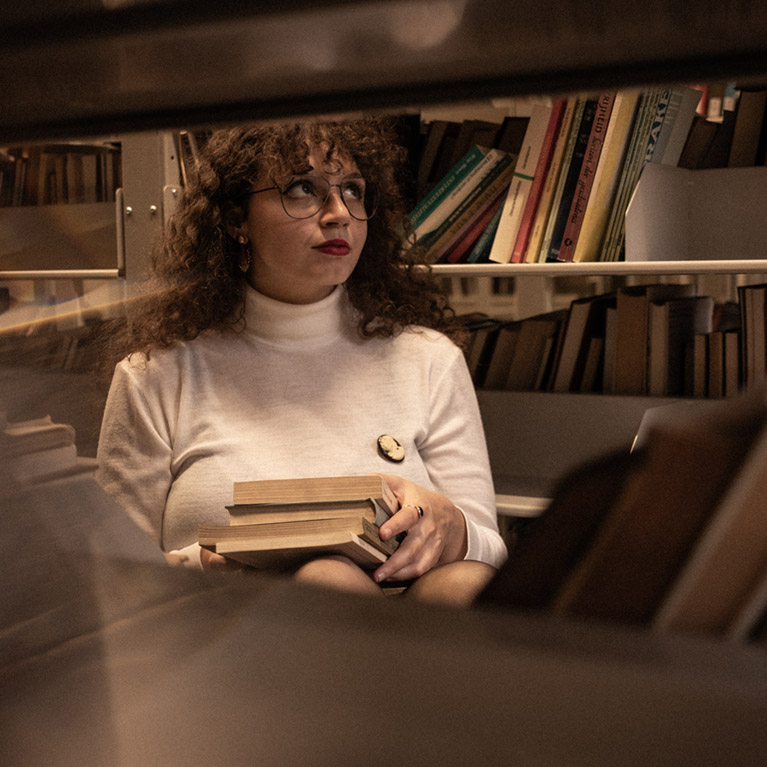
When she’s not reading the Brönte sisters or Mary Shelley, art history student Yasmine loves browsing antique stores for new trinkets to decorate her house. ‘I don’t mind this romanticisation of university’, says the Italian dark academia fan. ‘It helps you find the deep beauty in what you study.’
Here she is in the former library of the Faculty of Religion, Culture and Society at the Oude Boteringestraat 38, one of the oldest constructions in town. It was built in the 15th century and housed various prominent families from Groningen’s history.
The library was turned into a study area in 2014 and the bulk of the books were moved to the UB, but there are enough left to immerse yourself in that typical old book smell and the feeling of knowledge acquired through the ages.
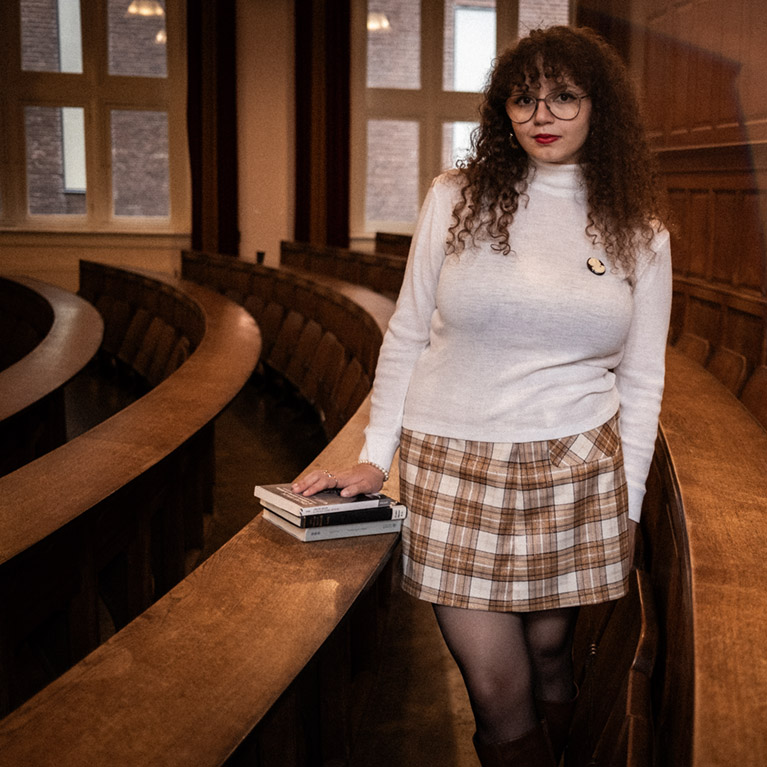
Yasmine loves her classes in the Heymanszaal, a room she calls ‘visually stimulating’. The lecture hall, located in the far east wing of the Academy building, is from 1909 and is still in its original state. ‘I come from a place where buildings weren’t prioritised at all, with the ceilings falling in, which makes me appreciate the noble beauty of the Heymanszaal even more.’
The room was named after Gerard Heymans (1857-1930), a former UG professor, rector and pioneer of experimental psychology in the Netherlands. It was here that he taught his students about his insight into the human mind, different human ‘temperaments’, and even telekinesis.
Escapism
Dark academia does not care for the practical Harmonie building and it has no love for the hypermodern Bernoulliborg. Instead, it focuses on places like the Academy building or the Bouman building - old and beautiful architecture that was designed to be stately.
Its glorification of studying at university is often linked to escapism. ‘Students are told they become part of this grand tradition of centuries of intellectual thought’, De Wildt says. ‘But the reality often looks quite different.’
Instead of becoming part of this grand tradition, students were in Zoom classes
They get class in boring lecture rooms, with tube lighting on the ceiling, projectors that don’t work and professors who can’t figure out computers. ‘That’s real academia’, De Wildt explains, ‘but that’s not what we want to romanticise.’
Escapism also explains why dark academia peaked online during the pandemic, when students didn’t get to live any of that nice, romantic, nostalgic life that people have enjoyed for centuries in cities like Heidelberg or Groningen or Oxford. ‘Instead, they were in Zoom classes.’
Hence, they escaped to virtual university life, posting pictures of old university buildings or dressing in nostalgic tweed outfits. ‘Dark academia is a recognition of what was lacking from attending a university online, which is not the educational part, but all the pomp and aesthetic and the status’, De Wildt explains. ‘It’s an imagined escape to a romanticised late-mediaeval elite European university.’
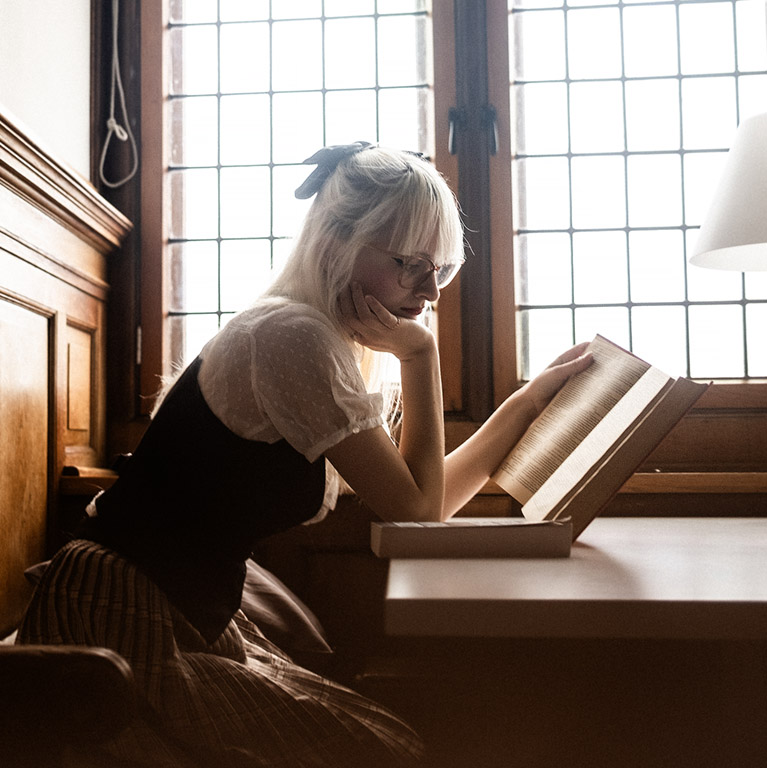
Madeline dreams of becoming a librarian. After trying out different aesthetics, it was vintage fashion and her re-discovered love for literature that made her stick to dark academia. ‘The obsessive nature of it motivates me,’ the French arts, culture and media student explains. Her favourite pieces of dark academia fashion include a burgundy cardigan and ‘a dress I haven’t found yet’.
She is photographed in a part of the university that perfectly unites the visual magnificence and elite education that dark academia celebrates: the Honours College. It is located in the Academy building’s tower, which, now more than a century old, embodies dark academia with its winding staircase, stained-glass windows and smart students leafing through thick books in every corner.
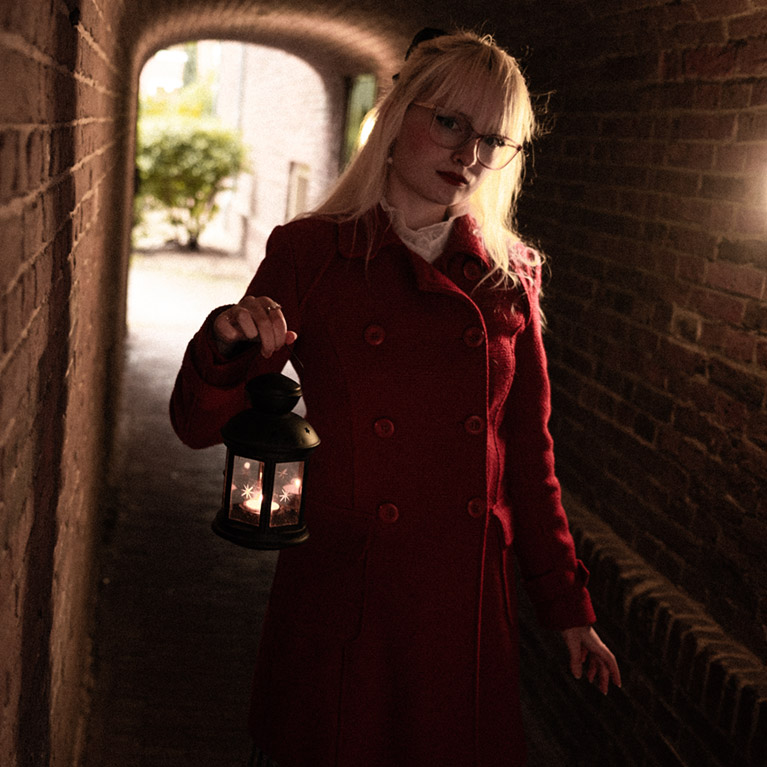
Like Yasmine, Madeline loves the building of the Faculty of Religion, Culture and Society. ‘The atmosphere still screams old books on rainy afternoons’, she says.
Here, she finds herself in one of the oldest parts of the six-century old building that served as Groningen’s courthouse from 1754 until the university acquired it in 1998: the narrow tunnel that leads from the courtyard to the garden in the back.
The whole street has always been a prestigious area with large townhouses owned by affluent Groningers, and one look at the imposing building of the philosophy faculty at number 52 - built around 1300 - demonstrates why the Oude Boteringestraat is considered one of the most well-preserved places in the city. Madeline, with her love of vintage clothing and books, fits right in here.
Elite
The ‘dark’ part of dark academia is commonly explained in its affinity for rainy autumnal weather, dark-coloured clothes or the imposing gothic buildings of old universities. But there might be another gloomy twist to dark academia: its exclusivity.
De Wildt describes the aesthetic as nostalgic, elite, Eurocentric. ‘It’s romanticising a tradition that, let’s be honest, until a century ago was only for white elites in Europe.’
It’s very much a white women’s aesthetic for some reason
For his own research on the topic, he collected a sample of the hundred most popular TikToks with a dark academia hashtag to see who creates these videos. ‘We noticed it was very female-dominant, there were very few men in them and only a handful of non-white people. So it’s very much a white women’s aesthetic for some reason.’
He can only speculate about the reasons. ‘It could just be that white men, for instance, don’t feel like they have to try that hard to belong to university, since they have historically always been part of this elite atmosphere.’
He refers to the portraits of emeriti professors in the Senate Chamber as an example. ‘I can just look at these portraits and basically see myself reflected. So maybe there is less of a need for me to try out his aesthetic online because I am already represented.’
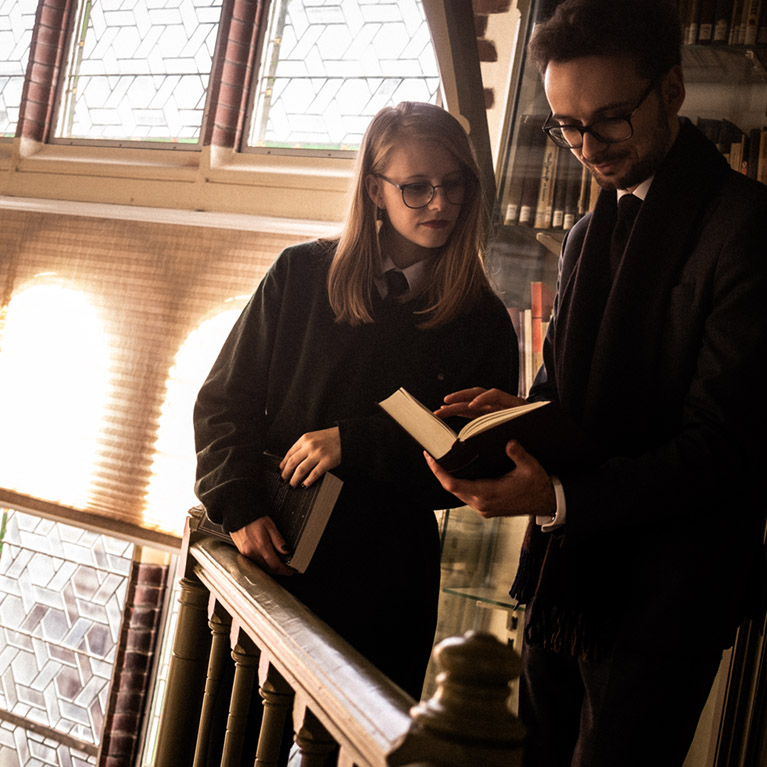
Couple Kik and Zsolt met in a way that couldn’t possibly be more dark academia. They ran into each other at the Academy building. ‘Kik was coincidentally wearing the same skirt as today and I was wearing a hideous navy coat that I haven’t worn since that fateful day’, Zsolt recalls.
For him, dark academia is not just about being studious, but also about dressing to impress. ‘My sense of fashion is heavily influenced by my grandparents. My grandma always used to tie my grandpa’s tie for him and this taught me to always look presentable. Not just for myself, but also for those around me.’
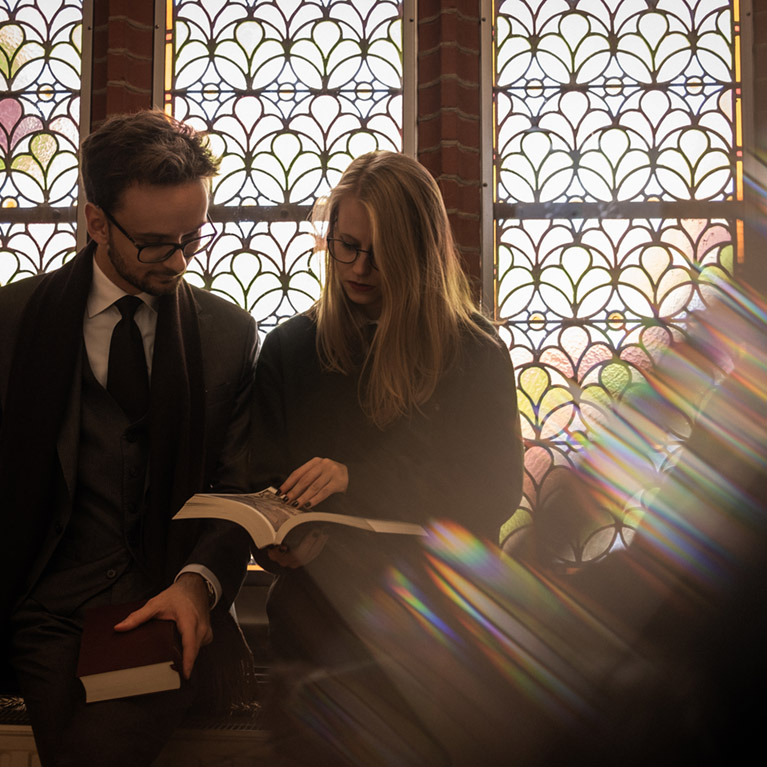
Kik’s fascination for dark academia is visible not just in her fashion sense, but also in her study choice. ‘I used to work in a library and there were those old books with anatomical sketches in them, which mesmerised me. I knew then I wanted to study and research biology.’
Consistent with the dark academia aesthetic, Kik loves to make her own jewellery in her free time or read and write poetry. ‘But I don’t write poetry in a journal. It’s on a laptop sadly, not quite as romantic’, she admits.
Both students are pictured in the Bouman building, which now houses sociology. It was erected in 1899 as a pharmaceutical lab, but before that this was where professor of botany Petrus de Boer lived, right next to the Hortus Botanicus where he did his research.
Photo contest
Do you know more spots at the UG that just scream ‘dark academia’? Send a photo featuring you or another model at an atmospheric uni location to [email protected] by December 10 at the latest. Don’t forget to tell us where it was taken and why you love that place so much! The person who sends in the best picture wins a copy of Donna Tartt’s The Secret History and a 50 euro gift certificate. And of course, we will publish a selection of the coolest shots.